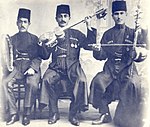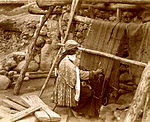ദെദേ കോർകുട്ടിന്റെ പുസ്തകം
| by an anonymous writer | |
 Front page of the Dresden manuscript | |
| Original title | Dresden manuscript: Kitāb-ı Dedem Ḳorḳud Alā Lisān-ı Tāife-i Oġuzān (The Book of my Grandfather Korkut according to the language of the tribe of the Oghuz)[1] Vatican manuscript: Hikāyet-ı Oġuznāme-ı Kazan Beġ ve Gayrı (The Story of Oguzname, Kazan Beg and the Others)[2] Gonbad manuscript: Cild-i Duyyum-i Kitāb-i Türkmän (ä)lsānî (The Second Volume of the Book of the Turkmens)[3] |
|---|---|
| Country | Aq Qoyunlu |
| Language | Old Anatolian Turkish[4] |
| Subject(s) | The stories carry morals and values significant to the social lifestyle of the nomadic Turks. |
| Genre(s) | Epic poetry |
| Publication date | c. 14th or 15th century |
| Heritage of Dede Qorqud/Korkyt Ata/Dede Korkut, epic culture, folk tales and music | |
|---|---|
| Country | Azerbaijan, Kazakhstan and Turkey |
| Reference | 1399 |
| Region | Europe and North America |
| Inscription history | |
| Inscription | 2018 (13th session) |
ഒഗുസ് തുർക്കികളുടെ ഇതിഹാസ കഥകളിൽ ഏറ്റവും പ്രസിദ്ധമാണ് ദെദേ കോർകുട്ടിന്റെ പുസ്തകം അല്ലെങ്കിൽ കോർകുട്ട് ആറ്റയുടെ പുസ്തകം (അസർബൈജാനി: കിതാബി-ഡാഡേ ഖോർഖുദ്, کتاب دده قورقود; തുർക്ക്മെൻ: കിറ്റാബി ഡെഡെം ഗോർകുട്ട്; ടർക്കിഷ്: ദേദേ കോർകുട്ട് കിതാബി) . നാടോടികളായ തുർക്കിക് ജനതയുടെ സാമൂഹിക ജീവിതശൈലിയിലേക്കും അവരുടെ ഇസ്ലാമിന് മുമ്പുള്ള വിശ്വാസങ്ങളിലേക്കും കഥകൾ ധാർമ്മികതയും മൂല്യങ്ങളും വഹിക്കുന്നു. പ്രധാനമായും തുർക്കി, അസർബൈജാൻ, തുർക്ക്മെനിസ്ഥാൻ എന്നിവിടങ്ങളിലെ ഒഗൂസ് തുർക്കിക് വംശജരുടെ സാംസ്കാരിക പൈതൃകത്തിന്റെ ഭാഗമാണ് പുസ്തകത്തിന്റെ പുരാണ ആഖ്യാനം.[5]
ഈ പുസ്തകത്തിന്റെ രണ്ട് കൈയെഴുത്തുപ്രതികൾ, വത്തിക്കാൻ , ഡ്രെസ്ഡൻ എന്നിവിടങ്ങളിൽ മാത്രമേ 2018 വരെ അറിയപ്പെട്ടിരുന്നുള്ളൂ. എന്നിരുന്നാലും, ഗോൺബാദ് കൈയെഴുത്തുപ്രതിയുടെ കണ്ടെത്തലോടെ ഈ പുസ്തകത്തിലേക്ക് ഒരു പുതിയ ഇപ്പോസ് ചേർത്തു. ഗോൺബാദ് കൈയെഴുത്തുപ്രതിയുടെ ഭാഷ സമ്മിശ്ര സ്വഭാവമുള്ളതാണ്. പിന്നീട് പഴയ ഓഗൂസ് തുർക്കിക്കിൽ നിന്ന് ഇറാനിയൻ അസർബൈജാനിലെ ആദ്യകാല ആധുനിക തുർക്കിക്കിലേക്കുള്ള പരിവർത്തന കാലഘട്ടത്തിന്റെ വ്യക്തമായ സവിശേഷതകൾ ചിത്രീകരിക്കുന്നു. എന്നിരുന്നാലും, കിഴക്കൻ തുർക്കിക്ക് സവിശേഷമായ അക്ഷരശാസ്ത്ര, നിഘണ്ടു, വ്യാകരണ ഘടനകളും ഉണ്ട്. ഇത് യഥാർത്ഥ കൃതി സിർദാര്യയ്ക്കും അനറ്റോലിയയ്ക്കും ഇടയിലുള്ള പ്രദേശത്താണ് എഴുതിയതെന്നും പിന്നീട് പതിനാറാം നൂറ്റാണ്ടിന്റെ രണ്ടാം പകുതിയിൽ സഫാവിഡ് ഇറാനിൽ വീണ്ടും എഴുതപ്പെട്ടുവെന്നും കാണിക്കുന്നു. പിന്നീട് 18-ആം നൂറ്റാണ്ടിന്റെ രണ്ടാം പകുതിയിൽ ഖജർ കാലഘട്ടത്തിൽ അതേ പ്രദേശത്ത് വീണ്ടും പകർത്തി.[6] ഗോൺബാദ് കൈയെഴുത്തുപ്രതിയുടെ ആദ്യ താളുകൾ കാണുന്നില്ല. ഇക്കാരണത്താൽ, കൈയെഴുത്തുപ്രതിയുടെ പേര് എങ്ങനെയാണ് രേഖാമൂലം രേഖപ്പെടുത്തിയതെന്ന് അറിയില്ല.[7]
മംഗോളിയൻ, തുർക്കി ഭാഷാ കുടുംബങ്ങൾക്കിടയിൽ രേഖപ്പെടുത്തിയിട്ടുള്ള 1,000-ത്തിലധികം ഇതിഹാസങ്ങളിൽ നിന്നുള്ള ഏറ്റവും പ്രശസ്തമായ തുർക്കിക് ദാസ്താനുകളിൽ ചിലതാണ് ദെദേ കോർകുട്ടിന്റെ ഇതിഹാസ കഥകൾ.[8]
ഇതിഹാസത്തിന്റെ ഉത്ഭവവും സംഗ്രഹവും[തിരുത്തുക]
ഒഗൂസ് തുർക്കിക് ജനതയിൽ ഒഗുസ്-നാമേ എന്നും അറിയപ്പെടുന്ന ഒരു വീരനായ ദാസ്താൻ (ഇതിഹാസം) ആണ് ദെദേ കോർകുട്ട്[9] ഇവർ മധ്യേഷ്യയിൽ തുടങ്ങി, അനറ്റോലിയയിൽ തുടരുകയും അസർബൈജാനി കോക്കസസിൽ ഭൂരിഭാഗം പ്രവർത്തനങ്ങളും കേന്ദ്രീകരിക്കുകയും ചെയ്യുന്നു.[10]ബാർത്തോൾഡിന്റെ അഭിപ്രായത്തിൽ, "ഈ ദസ്താൻ കോക്കസസിൽ അല്ലാതെ മറ്റെവിടെയെങ്കിലും എഴുതപ്പെട്ടിരിക്കുമെന്ന് ഊഹിക്കാൻ കഴിയില്ല".[11]
തുർക്കിക് ജനതയ്ക്ക്, പ്രത്യേകിച്ച് ഒഗൂസ് എന്ന് സ്വയം തിരിച്ചറിയുന്ന ആളുകൾക്ക്, ചരിത്രത്തിലുടനീളം തുർക്കിക് ജനതയുടെ വംശീയ സ്വത്വം, ചരിത്രം, ആചാരങ്ങൾ, മൂല്യ വ്യവസ്ഥകൾ എന്നിവയുടെ പ്രധാന ശേഖരമാണിത്. ഒഗൂസ് തുർക്കികൾ ഒരു ആട്ടിടയ ജനതയായിരുന്ന കാലത്തെ സ്വാതന്ത്ര്യത്തിനായുള്ള പോരാട്ടങ്ങളെ ഇത് അനുസ്മരിക്കുന്നു, എന്നിരുന്നാലും "ഓഗൂസ് വംശജരായ തുർക്കികൾ തങ്ങളെ ഓഗൂസ് ആയി കണക്കാക്കാത്ത സമയത്താണ് കഥകൾ അവയുടെ ഇന്നത്തെ രൂപത്തിലേക്ക് കൊണ്ടുവന്നതെന്ന് വ്യക്തമാണ്."[12]പത്താം നൂറ്റാണ്ടിന്റെ മധ്യം മുതൽ, ഒഗുസ് എന്ന പദം തുർക്കികൾക്കിടയിൽ തന്നെ തുർക്കോമാൻ ക്രമേണ മാറ്റിസ്ഥാപിച്ചു, ഈ പ്രക്രിയ പതിമൂന്നാം നൂറ്റാണ്ടിന്റെ ആരംഭത്തോടെ പൂർത്തിയായി. ഇസ്ലാം മതം സ്വീകരിക്കുകയും തങ്ങളുടെ പൂർവ്വികരെക്കാൾ കൂടുതൽ ഉദാസീനമായ ജീവിതം നയിക്കാൻ തുടങ്ങുകയും ചെയ്തിരുന്ന തുർക്കികൾ ആയിരുന്നു ടർക്കോമൻമാർ. [13]14-ആം നൂറ്റാണ്ടിൽ, ഓഗൂസിന്റെ ഒരു ഫെഡറേഷൻ, അല്ലെങ്കിൽ, അക്-കൊയൂൻലു എന്ന് സ്വയം വിശേഷിപ്പിച്ച ടർക്കോമൻ ഗോത്രവർഗ്ഗക്കാർ, കിഴക്കൻ തുർക്കി, അസർബൈജാൻ, ഇറാഖ്, പടിഞ്ഞാറൻ ഇറാൻ എന്നിവ ഭരിച്ച ഒരു രാജവംശം സ്ഥാപിച്ചു.[14]
Notes[തിരുത്തുക]

അവലംബം[തിരുത്തുക]
- ↑ Karl Reichl (2011). Medieval Oral Literature. p. 687.
- ↑ Felix J. Oinas (1978). Heroic Epic and Saga: An Introduction to the World's Great Folk Epics. p. 312.
- ↑ Youssef Azemoun (2022). "The New Dädä Qorqut Tales from the Recently-Found Third Manuscript of the Book of Dädä Qorqut". Istanbul, Turkey: 18.
{{cite journal}}: Cite journal requires|journal=(help) - ↑ George N. Rhyne and Bruce Friend Adams (editors) (2006), The Supplement to The Modern Encyclopedia of Russian, Soviet and Eurasian History, Volume 7, page 224
- ↑ Barthold (1962)""The book of my grandfather Korkut" ("Kitab-i dedem Korkut") is an outstanding monument of the medieval Oghuz heroic epic. Three modern Turkic-speaking peoples - Turkmens, Azerbaijanis and Turks - are ethnically and linguistically related to the medieval Oghuzes. For all these peoples, the epic legends deposited in the "Book of Korkut" represent an artistic reflection of their historical past."
- ↑ Mahsun Atsız (2020). "Korkut Ata Türkiyat Araştırmaları Dergisi: A Syntactic Analysis on Gonbad Manuscript of the Book of Dede Korkut": 189. ISSN 2687-5675.
{{cite journal}}: Cite journal requires|journal=(help) - ↑ "DEDE KORKUT OĞUZNAMELERİ ÜZERİNE-Günbed Nüshası Işığında-DÜZELTME TEKLİFLERİ (2)" (50). Ankara, Turkey: Türk Dünyası Dil ve Edebiyat Dergisi / Turkish World Journal of Language and Literature. Autumn 2020.
{{cite journal}}: Cite journal requires|journal=(help) - ↑ Rinchindorji. "Mongolian-Turkic Epics: Typological Formation and Development" Archived 2017-12-02 at the Wayback Machine., Institute of Ethnic Literature, Chinese Academy of Social Sciences, Trans. by Naran Bilik, Oral Tradition, 16/2, 2001, p. 381
- ↑ "Dastan". Great Soviet Encyclopedia (in 30 volumes), Third edition, Moscow, 1970
- ↑ ""КиÑ'аби деде Коркуд"". archive.is. 25 May 2005. Archived from the original on 25 May 2005. Retrieved 26 January 2019.
- ↑ Barthold (1962), പുറം. 120
- ↑ Lewis (1974), പുറം. 9
- ↑ Lewis (1974), പുറം. 10
- ↑ Lewis (1974), പുറം. 16–17
ഗ്രന്ഥസൂചിക[തിരുത്തുക]
- Barthold, V., ed. (1962). The book of my grandfather Korkut. Moscow and Leningrad: USSR Academy of Sciences.
- Kafadar, Cemal (1996). Between Two Worlds: the Construction of the Ottoman State. University of California Press. ISBN 9780520206007.
- Lewis, Geoffrey, ed. (1974). The Book of Dede Korkut. Harmondsworth, UK: Penguin Books. ISBN 9780140442984.
കൂടുതൽ വായനയ്ക്ക്[തിരുത്തുക]
- Azmun, Y. (2020). "The New Dädä Qorqut Tales from the Recently-Found Third Manuscript of the Book of Dädä Qorqut". In: Journal of Old Turkic Studies, 4 (1), 16-27. DOI: 10.35236/jots.677980
- Haznedaroğlu, A. (2020). "Salur Kazan ve Yuvarlanan Taş Anlatısı Hakkında". In: Journal of Old Turkic Studies, 4 (2), 437-468. DOI: 10.35236/jots.736370 (In Turkish)
- Rentzsch, Julian. “MODALITY IN THE ‘DEDE QORQUD OĠUZNAMELERI’.” In: Acta Orientalia Academiae Scientiarum Hungaricae 64, no. 1 (2011): 49–70. http://www.jstor.org/stable/43282396.
External links[തിരുത്തുക]

- Epics Archived 2012-01-05 at the Wayback Machine., four editions of the Dede Korkut book at the Uysal-Walker Archive of Turkish Oral Narrative, Texas Tech University, 2000–2007
- "Mother-of-All-Books" Dada Gorgud article in Azerbaijan International magazine
- First and second parts of the 1975 Dede Korkut film (in Azerbaijani)
- Book of Dede Korkut at Dresden Library
- "КНИГА ДЕДА КОРКУТА". Восточная Литература - библиотека текстов Средневековья.
- Dede Korkut literature


